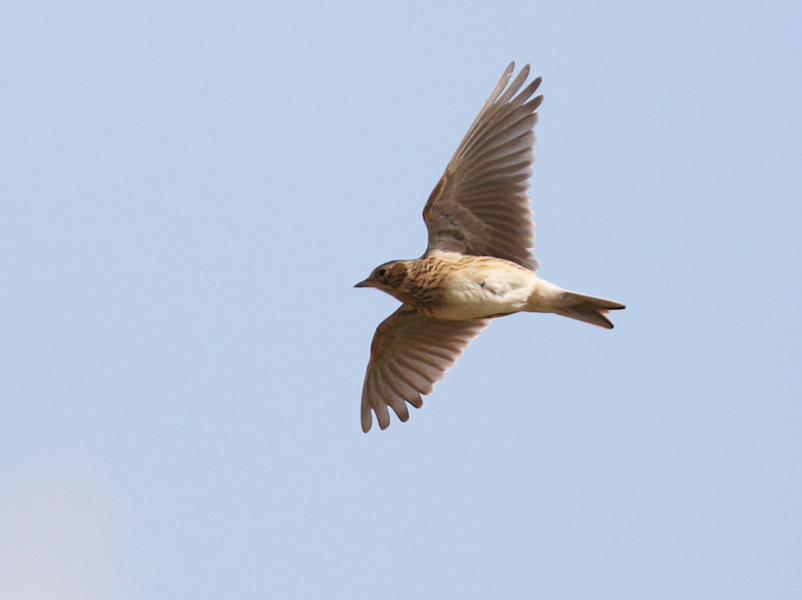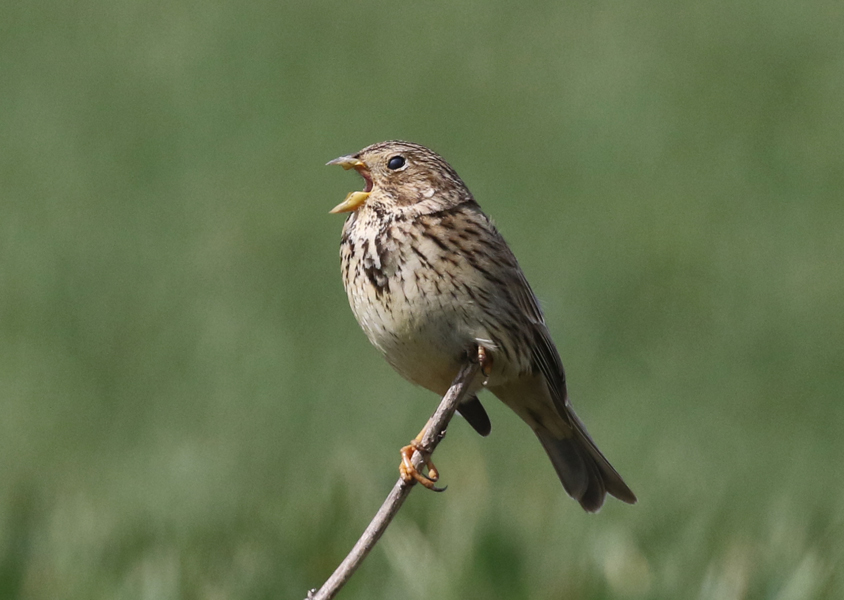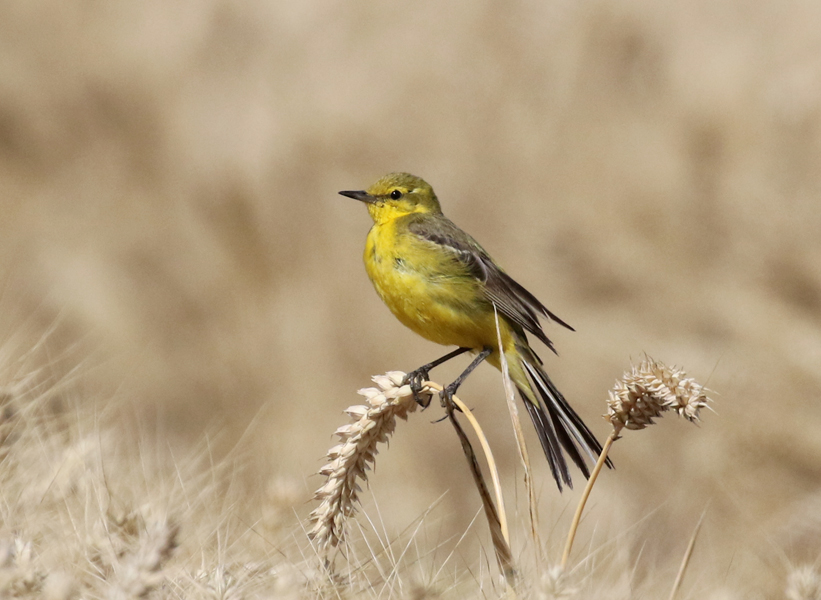The Butts at Hawley – Farmland Birds

Habitat: Arable Farmland
Time of Year: Spring/Summer
An area of farmland bounded by the villages of Hawley, Wilmington and Hextable, near Dartford in Kent, is locally known as “The Butts” consisting of a set of fields upon which a variety of arable crops are grown on rotation along with irrigated vegetable crops. Wheat, Barley, Oilseed Rape, Peas, Linseed and Onions are the main crops usually grown here but there are areas of pasture where horses are kept as well as a large hay field. There are also some mature hedgerows and a small area of woodland bordering the west of the site adding some habitat diversity to the area. The area is traversed by the A2 and M25 motorways and the verges of these have allowed many species of wildflowers to spread in the area including Pyramidal Orchid.
I have been visiting this area since I was able to walk and some species of birdlife associated with farmland continue to do well here; it is a particularly pleasant place to walk on sunny spring and summer evenings.

Although there is a variety of common farmland birds to see at The Butts the most obvious reasons to visit this location is to enjoy a pair of farmland species that are in decline across the United Kingdom; namely Corn Bunting and Eurasian Skylark.
Even though the land here is fairly intensively farmed large numbers of Skylarks can be seen and heard all over this site and the number of Corn Bunting territories here is still in double figures. In fact this site is probably the stronghold of Corn Bunting in Northwest Kent and in late Spring into Summer it doesn’t take much walking before one is heard calling from an elevated perch.

For anyone who wants to get close to these farmland birds this site presents a great opportunity. With Corn Bunting now absent from large parts of the British countryside this location is worth a visit for anyone who is targeting this species for either the first time or to get more familiar with a bird perhaps seen on a very infrequent basis. Equally, for birders who want to get close views of singing Skylarks this is a very good spot and presents a lot of opportunities to photograph them as they ascend into song flight.
A few pairs of Western Yellow Wagtails occasionally breed in some of the fields wherever puddles form around areas of irrigation. This species can also turn up as a passage migrant in Spring and Autumn along with Meadow Pipits and a sometimes a Wheatear or two. Huge numbers of Common Swift can sometimes be seen feeding here before their departure in late July and small numbers of Barn Swallow breed in a few farm buildings while commoner birds include Linnet, Common Whitethroat and House Sparrow.
- Greylag Goose – Anser anser
- Canada Goose – Branta canadensis
- Egyptian Goose – Alopochen aegyptiaca
- Mallard – Anas platyrhynchos
- Red-legged Partridge – Alectoris rufa
- Common Pheasant – Phasianus colchicus
- Feral Pigeon – Columba livia
- Stock Dove – Columba oenas
- Woodpigeon – Columba palumbas
- Collared Dove – Streptopelia decaocto
- Common Swift – Apus apus
- European Golden Plover – Pluvialis apricaria
- Eurasian Dotterel – Charadrius morinellus
- Northern Lapwing – Vanellus vanellus
- Eurasian Curlew – Numenius arquata
- Black-headed Gull – Chroicocephalus ridibundus
- Common Gull – Larus cranus
- Herring Gull – Larus argentatus
- Yellow-legged Gull – Larus michahellis
- Lesser Black-backed Gull – Larus fuscus
- Great Black-backed Gull – Larus marinus
- Grey Heron – Ardea cinerea
- Little Egret – Egretta garzetta
- Western Marsh Harrier – Circus aeruginosus
- Eurasian Sparrowhawk – Accipiter nisus
- Red Kite – Milvus milvus
- Common Buzzard – Buteo buteo
- Great Spotted Woodpecker – Dendrocopos major
- Eurasian Green Woodpecker – Picus viridis
- Common Kestrel – Falco tinnunculus
- Eurasian Hobby – Falco subbuteo
- Peregrine Falcon – Falco peregrinus
- Ring-necked Parakeet – Psittacula krameri
- Eurasian Jay – Garrulus glandarius
- Common Magpie – Pica pica
- Eurasian Jackdaw – Corvus monedula
- Rook – Corvus frugilegus
- Carrion Crow – Corvus corone
- Eurasian Blue Tit – Cyanistes caeruleus
- Great Tit – Parus major
- Eurasian Skylark – Alauda arvensis
- Sand Martin – Riparia riparia
- Barn Swallow – Hirundo rustica
- Common House Martin – Delichon urbicum
- Common Chiffchaff – Phylloscopus collybita
- Long-tailed Tit – Aegithalos caudatus
- Eurasian Blackcap – Silvia atricapilla
- Common Whitethroat – Sylvia communis
- Goldcrest – Regulus regulus
- Eurasian Wren – Troglodytes troglodytes
- Common Starling – Sturnus vulgaris
- Mistle Thrush – Turdus viscivorus
- Song Thrush – Turdus philomelos
- Redwing – Turdus iliacus
- Eurasian Blackbird – Turdus merula
- Fieldfare – Turdus pilaris
- European Robin – Erithacus rubecula
- Northern Wheatear – Oenanthe oenanthe
- Dunnock – Prunella modularis
- House Sparrow – Passer domesticus
- Western Yellow Wagtail – Motacilla flava
- Pied Wagtail – Motacilla alba
- Meadow Pipit – Anthus pratensis
- Common Chaffinch – Fringilla coelebs
- European Greenfinch – Chloris chloris
- Common Linnet – Linaria cannabina
- European Goldfinch – Carduelis carduelis
- Corn Bunting – Emberiza calandra
- Yellowhammer – Emberiza citrinella
The interactive map below shows the route, by road, from junction 2 of the M25 motorway (A) to a suitable parking location on Capel Place (B) and onto the centre of the site where a public footpath crosses Shirehall Road.
Car/Motorcycle
The only places to park are in residential areas close to the fields. Capel Place is a suitable spot with no houses along part of the road meaning that obstructing local residents should not be a problem. Alternatively it is usually possible to find somewhere to park along Ethelbert Road or Alfred Road in the vilage of Hawley.
Rail
The nearest railway stations are Dartford, Farningham Road and Swanley. All three are 2-3 miles away from the birding site.
1. Entering The Butts along this footpath, a large hay field is on the left. From early spring good numbers of Skylark sing and in late May to early July huge numbers of cockchafers emerge from the hedgerow and are fed upon by clouds of Swifts and up to 5 Hobbies; the latter sometimes stay around to breed.

2. Arable fields are criss-crossed by footpaths and are good spots to watch singing Skylarks, Linnets and noisy calling Corn Buntings. Corn Buntings have become scarce or absent in many areas, but this is still a great place to see them close-up and in July it is easy to watch the parents feeding their chicks, often following the combine harvesters and catching the insects that they disturb.
3. Some scrubland and horse pasture is home to Whitethroat, Kestrel and a few pairs of Yellowhammers, as well as many common species: the pasture is where most passage migrants turn up in spring.
4. Irrigated crops, often including onions, sometimes host a few pairs of Western Yellow Wagtails in spring and early summer while the buildings associated with the horse paddocks provide nesting opportunities for a few pairs of Barn Swallows which can be seen hawking over the surrounding fields in summer.
 Corn Bunting
Corn Bunting Linnet
Linnet Eurasian Skylark
Eurasian Skylark Redwing
Redwing Common Buzzard
Common Buzzard Blackcap
Blackcap
All photos copyright Nick Upton/Birdnerd.co.uk.
- Eurasian Skylark Song Flights in Early Spring – posted by Nick Upton 28/03/21
- Farmland Birds – posted by Nick Upton 27/06/18
- Survey of Calling Male Corn Buntings – posted by Nick Upton 03/07/17
- Spring Birding in UK – posted by Nick Upton 11/05/17





